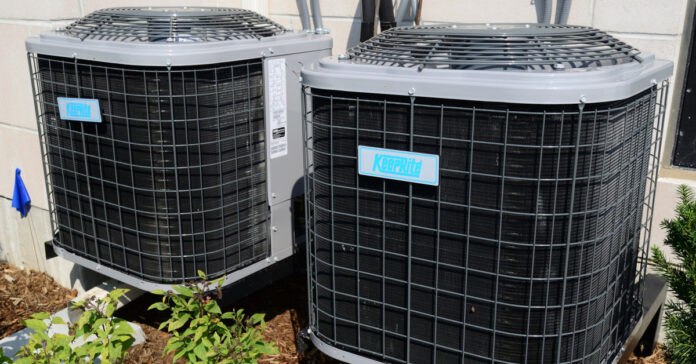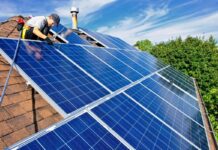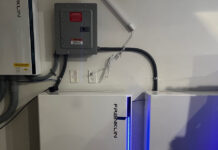
The HVAC folks came out Wednesday, the day after we called them, which was a blessing. Their technician quickly diagnosed and fixed the problem using a part he had on his truck. The surge had burned out a transformer. The transformer took the 240 power and reduced it to 24 volts for the thermostat. Without the thermostat, we had no way to turn the AC on.
It cost $250, but the solar folks will pay for it.
The appliance repair guys showed up Thursday. Sadly, the oven was not such an easy fix. Its fuse (a thermal fuse) was fine, meaning a component on the control board was fried. He told us the cost would be $300 to $500, and he’d let us know after he got back to his office and looked it up.
He called back that afternoon, but only to tell us he couldn’t get the part because the oven was too old. My wife is already shopping for new ovens. She picked out a model that will run $2200 with delivery and installation. It will be interesting to see if the solar people will pay for the whole thing. You can buy an inexpensive oven for $1200. If they argue, I’ll settle for $1,500 and pay the difference.
I didn’t realize how often my wife uses the oven. In its absence, she has used the toaster oven and the InstaPot. She’s planning to grill on the propane grill this weekend. This is good practice for a power outage, however, because the oven uses a large amount of power.
Surge Protection
When the installer followed up with Franklin Whole House, the manufacturer, they were told that if the house had a whole-house surge protector, the generator problem wouldn’t have blown out our appliances. Such a surge protector is called for in the 2020 national electric code. Where we live, we are still operating under an older version of the code. (I don’t know if that is a county or a state determination; either way, I’m not shocked we are behind the times.) We may get such a protector.
I talked to the installer about the cost of a basic surge protector versus a surge protector rated for EMP. The devices from EMP Shield are more expensive, and we’d need one on the DC side and another on the AC side. I’m getting a quote, but have not made a decision yet. Half of me believes the difference between an EMP Shield and a standard surge protector is the name and a couple hundred dollars of profit.
Also, if we get into a scenario where there is an EMP attack, I think it’s unlikely to be a single strike. I expect most of the surge protection devices are self-sacrificial, so they will only work on the first strike. If we’re in a war in which multiple nukes or EMPs are fired/exchanged, protecting ourselves once might not be sufficient. If we know an attack is coming, I could throw the disconnectors to insulate the equipment from the solar panels and the grid, wait a few weeks for things to settle down, and then reconnect. Assuming we’re still alive.
First Lessons Living on Solar Power
Our first lesson in living with solar became clear the moment the air conditioner kicked on. AC consumes a huge amount of electricity. I knew that, in theory, but seeing the data on the screen in real time drives the lesson home. When the HVAC is running, the house consumes at least 4.3 kW.
Our last house, which was bigger, had three HVAC units, including one just for the basement. I can only imagine how much power they must have consumed if all three were running at the same time. Of course, that house had 400 amp electrical service, this one has a more traditional 200 amp service panel. Three HVACs and the warmer weather of the South explains why our electric bills there were about three times as high.
While the air conditioning was broken, we could charge our batteries during the day and go all night without using grid power. As soon as the AC got repaired, our electrical consumption shot up and we would run out of power around midnight.
I say “run out” of power, but what I mean is we reach the cutoff point where I didn’t want to drain my batteries any lower. I have the system set to leave 50 percent of the power in the batteries. This is to give us a cushion of power to fall back on if there are any power outages. If I used all 100 percent of my battery capacity, they would last all night, as long as we left the AC off. it would also leave us in the lurch if there were to be a power outage.
I am considering moving that cutoff point down to 40 percent and manually boosting it up to 60 percent or higher if we expect thunderstorms.
Second Lesson
All the 240 appliances use a large amount of power. Again, this should be obvious, but seeing the graph show consumption spike when you turn on the dryer drives it home. One time, when we used the cook top, the dryer, and the HVAC at the same time, we were using more than 11 kW. Keep in mind that our average consumption is less than 30 kWh per day.
To put the 11kW in perspective, our refrigerator uses about 1.5 kW per day. That’s an average of 62 watts per hour. The dryer can use that much in less than half an hour. If the grid is down and I can choose to run the dryer for half an hour or the refrigerator for the full day, I’m choosing the latter.
The dishwasher is also a power hog, but we run fewer loads of dishes than we do laundry.
Cooking also uses lots of power, regardless do whether it is the stove top of the toaster oven. I can only imagine what the numbers will look like when the oven works again. Looking at the Franklin app, we can see how consumption peaks when we are making breakfast or dinner.
Grid Down Planning
We’ve had the system up and running for half a week—a sunny week in the summer, which is optimum conditions—and I can already formulate a plan for a long-term grid down scenario.
Simply put, our plan will be to use power when the sun shines because that is when we have an abundance of it. Then we’ll conserve power at night when we are running off the batteries.
Some changes will be required. For example, after the SHTF, our largest, most complicated meal will have to be served—or at least prepared—midday, not in the evening. If we have to bake bread in the oven, it will also be done between 10 a.m. and 4 p.m. on a sunny day. In the winter, that will probably change to 11 a.m. and 3 p.m. Also in the winter, we’ll cook on the wood stove as much as possible.
Other appliances will also be used on sunny days. We’ll need to use the clothesline more often than we do today because the dryer is a waste of valuable electricity.
We’ll also be making much less hot water. People who want warm water will have to shower in the afternoon instead of in the morning.
In a post-SHTF grid-down scenario, we’ll also unplug many of those power siphons I mentioned in my last post, such as the TVs, laser printers, power bricks and electronic picture frames. Today, burning 500 watts of power an hour costs 7 cents, or $1.68 per day. When we have less than 30,000 watts in storage, we won’t be able to waste 12,000 of them on doodads and gadgets. Every watt will become more valuable because the sun isn’t always shining.
Lighting
Regardless of how much sun we get, the system will produce ample power for lighting. Even with LEDs, we won’t want to leave lights on in an empty room, but at 13 watts per bulb, we can run LED lightbulbs and use just 200 watts of power. Still, I expect we may go to bed earlier during a grid-down scenario. Not only will there be no TV and Internet to keep us up late, I expect we’ll be physically exhausted from all the manual labor and patrols we have to do.
The solar power system will also recharge small batteries during a grid-down scenario. I expect the most important will be those 18650 batteries used in flashlights, headlamps and rifle-mounted lights; the RCR123s and AAs used in a few of our weapons-mounted optics; and batteries for radios. Batteries for power tools will also need recharging. The battery-power chainsaw, which uses 40-volt batteries, could come in handy for cutting smaller logs without burning any precious gasoline. I doubt we’ll be using our battery-powered screwdrivers, hammer drill, circular saw, and grinder much because there will be a limited amount of lumber. I also have a large array of hand-tools, including manual powered drills.
We should also be able to recharge 12-volt car or marine batteries. That would be a valuable service to offer neighbors.
Winter will be the Test
I expect the solar power system will perform best on spring and fall days when it is cool enough that we don’t run the AC. Looking at the electric bills, it is months like May and October where we use the least power.
It will be interesting to see how the system performs in the winter when we have four or five fewer hours of sunshine.






